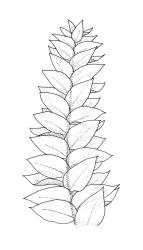- = Eriodon Mont., Ann. Sci. Nat., Bot. sér. 3, 4: 98 (1845) nom. rej.
Plants small to ± robust, yellow- to dark green, lustrous, forming interwoven mats, mostly on soil or rotten wood. Stems prostrate and creeping, irregularly to subpinnately branched, in cross-section with thick-walled outer cells surrounding large, thin-walled cells and usually with a distinct central strand (apparently absent in R. muriculatum), with fascicles of smooth, brown rhizoids on ventral surface. Branches prostrate or ascending. Stem and branch leaves differing by size only, or by both size and shape. Stem leaves broadly ovate to ovate-lanceolate, usually abruptly tapered to an acumen, usually narrowed to base and occasionally ± cordate, wide-spreading or erect-spreading, variably complanate, not plicate (but sometimes striolate, especially when dry), serrulate or denticulate above or to base; mid laminal cells linear-rhombic or linear, smooth, thin- or firm-walled, not porose; alar cells not differentiated or poorly so and ± quadrate. Costa single, tapered, mostly ending beyond mid leaf, with or without a terminal abaxial spine. Branch leaves usually differing only by their smaller size but sometimes more abruptly acuminate than stem leaves. Pseudoparaphyllia present and foliose. Gemmae nil.
Autoicous. Perichaetia scattered on stems (sometimes also on branches), with leaves ecostate, erect or (reportedly) sometimes spreading from an erect base. Setae elongate and slender, flexuose or nearly straight, smooth; capsules short oblong-cylindric to long-cylindric, inclined to horizontal, curved and asymmetric, narrowed below the mouth when dry; exothecial cells oblong to quadrate, ± collenchymatous in the N.Z. species; stomata restricted to extreme base of capsule, round-pored; annulus differentiated; operculum long-rostrate from a conic base, often ± equal the theca. Peristome perfect; exostome teeth yellow-brown, lanceolate and shouldered, bordered, transversely striate (in N.Z. species) or sometimes striolate on the outer surface, trabeculate on inner surface; endostome with a low or high basal membrane and perforate or gaping segments, which are nearly the height of the teeth; cilia in groups of 1–3, mostly well developed and nodose. Calyptra cucullate and smooth. Spores smooth or nearly so in N.Z. species.
The concept of Rhynchostegium presented here is narrower than that presented for Australia by Hedenäs (2002), who termed it a “highly artificial genus”. He included R. cylindritheca Dixon, which is here treated as an Eriodon (for reasons detailed under that genus). However, I agree with his assessment that the Australasian species previously assigned to Rhynchostegiella (as R. muriculata) is better included here. Hedenäs (2002) treated (including Eriodon cylindritheca) six species for Australia, all of which also occur in N.Z.
According to Ignatov et al. (1999), Rhynchostegium “includes species with long-beaked opercula, usually ovate-lanceolate leaves and a rather weak costa that is not toothed abaxially. Many species of Rhynchostegium have pale, somewhat transparent leaves and show a tendency to have capsules that are disproportionately small relative to the gametophytes. Their endostome is somewhat reduced, with the low basal membrane having narrow, unperforated segments and short cilia.” However, the species recognised here do not fully comply with this characterisation.
Poorly developed plants and those growing in marginal habitats are very difficult to name with confidence. While sporophytic characters are highly diagnostic, gametophytic characters are both less constant and less convincing, and a significant fraction of sterile collections cannot be confidently determined. Scott & Stone’s (1976, p. 431) suggestion that a “thorough revision [of Rhynchostegium] is needed” remains true more than 30 years after it was written. It is unlikely that a revision based solely on morphological features will greatly clarify the relationships between the Australasian species.
Both the distribution and the size of this large and taxonomically troublesome genus are difficult to summarise. Brotherus (1925) considered it to include 130 species, mostly distributed in temperate and subtropical regions. Three N.Z. species are recognised here.
Rhynchostegium species key, including Eriodon.
| 1 | Branch leaves mostly ≤0.4 mm wide and branches distinctly complanate; capsules narrowly cylindric; exostome teeth pale; endostome with cilia either absent or poorly developed and with linear, non-perforate segments; operculum very slender and elongate-rostrate, c. 1.2–1.6 mm | Eriodon cylindritheca |
| 1' | Branch leaves mostly >0.4 mm wide or if narrower then branches not distinctly complanate; capsules oblong-cylindric; exostome teeth yellow-brown; endostome with well-developed and nodose cilia and with non-linear, perforate segments; operculum long rostrate from a conic base, c. 1 mm | 2 |
| 2 | Costa of branch leaves often ending in a terminal spine; stems short, usually less than 20 mm; setae scabrose | R. muriculatum |
| 2' | Costa of branch leaves usually lacking a terminal spine; stems usually greater than 20 mm; setae smooth | 3 |
| 3 | Shoots (both stems and branches) distinctly complanate; branch leaves not striolate, distinctly lustrous when dry (suggestive of a Plagiothecium), 0.65–0.8 mm wide; stem leaf mid laminal cells mostly 90–135 µm; operculum ± equal the theca | R. tenuifolium |
| 3' | Shoots (both stems and branches) not complanate; branch leaves striolate and only weakly lustrous when dry, 0.4–0.55(–0.65) mm wide; stem leaf mid laminal cells mostly 54–90 µm; operculum distinctly shorter than the theca | R. laxatum |
| Category | Number |
|---|---|
| Indigenous (Non-endemic) | 3 |
| Total | 3 |
Rhynchostegium fragilicuspis Dixon [Bull. New Zealand Inst. 3(6): 329, 1929]. Dixon was uncertain about the generic placement of this species at the time of its description, and placed it in Rhynchostegium “provisionally” following an opinion from Brotherus. The type collection by W. Gray is from Great Barrier I. I have seen only a minute isotype (WELT M005809) and very much doubt that it belongs here. Several features, including the entire margins and differentiated alar cells, suggest that it might belong to the Amblystegiaceae. It is not in my opinion nameable and it is not considered further here.




